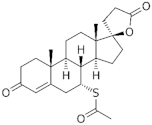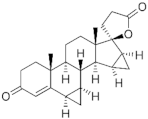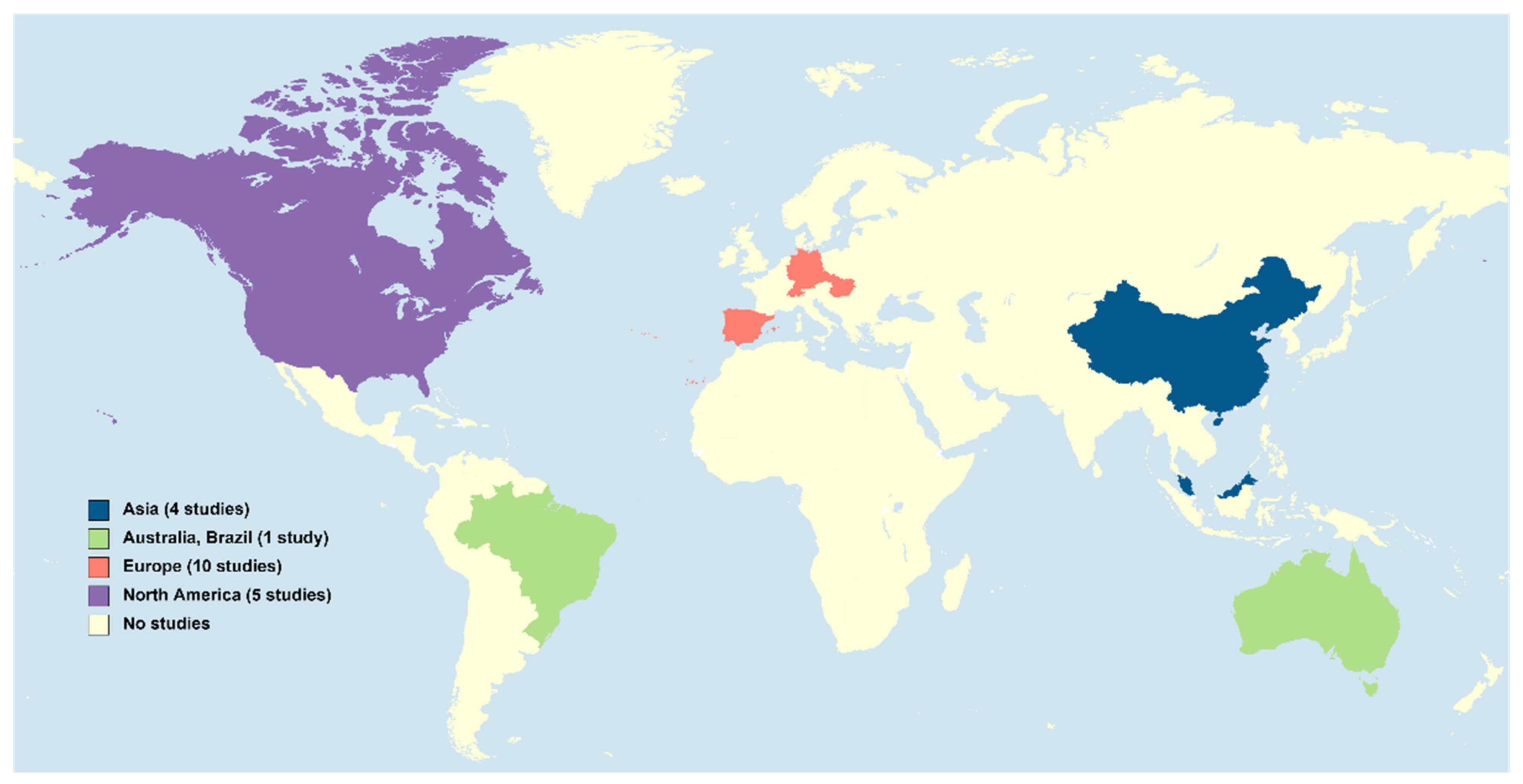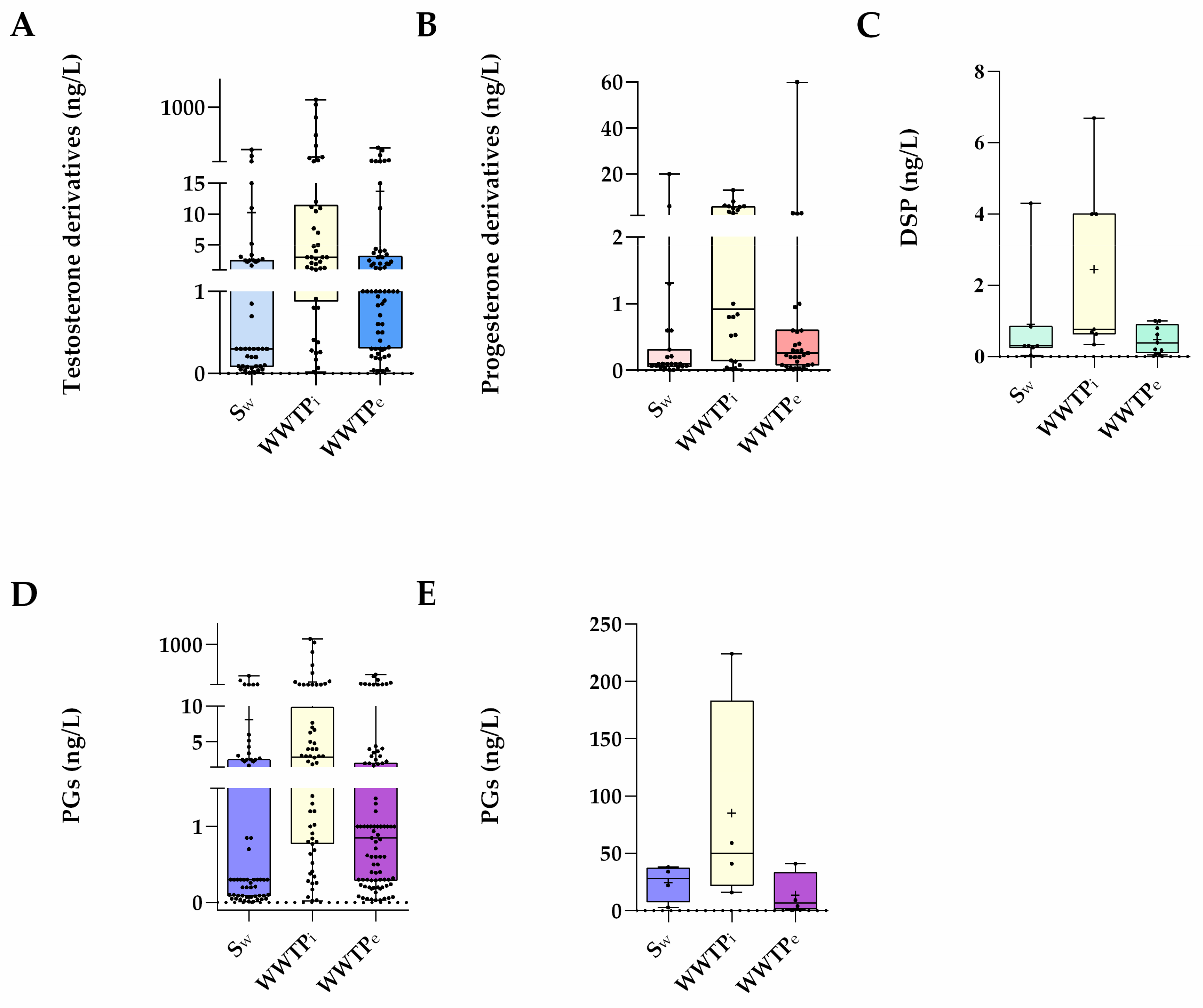
| Version | Summary | Created by | Modification | Content Size | Created at | Operation |
|---|---|---|---|---|---|---|
| 1 | Maria João Rocha | -- | 2862 | 2022-04-19 10:46:07 | | | |
| 2 | Camila Xu | Meta information modification | 2862 | 2022-04-19 11:01:00 | | | | |
| 3 | Camila Xu | Meta information modification | 2862 | 2022-04-21 08:23:24 | | | | |
| 4 | Camila Xu | Meta information modification | 2862 | 2022-04-21 08:24:11 | | | | |
| 5 | Camila Xu | -36 word(s) | 2826 | 2022-04-21 08:29:11 | | |
Video Upload Options
Synthetic progestins (PGs) are a large family of hormones used in continuously growing amounts in human and animal contraception and medicinal therapies. Because wastewater treatment plants (WWTPs) are unable to eradicate PGs after excretion, they are discharged into aquatic systems, where they can also be regenerated from conjugated PG metabolites. The PGs were considered of particular interest due to their wide use, activity, and hormonal derivation (from testosterone, progesterone, and spirolactone). It is concluded that PGs had been analysed in WWTPs influents and effluents and, to a lesser extent, in other matrices, including surface waters, where their concentrations range from ng/L to a few µg/L. Because of their high affinity for cell hormone receptors, PGs are endocrine disruptor compounds that may alter the reproductive fitness and development of biota.
1. Introduction
2. Classification and Properties of the Most Prominent PGs in Aquatic Environments
| Hormone | Family | Common Name (Acronym) & CAS | Structure & Molecular Formula |
Generation & Activity |
|
 19-Nortestosterone |
Gonanes (C17) or LNG family |
Gestodene (GES) 60282-87-4 |
 C21H28O2 |
3rd Generation 1986 (+++) |
|
| Levonorgestrel (LNG) 797-63-7 |
 C21H28O2 |
2nd Generation 1966 (+++) |
|||
| Norgestrel (NET) 6533-00-2 |
 C21H28O2 |
2nd Generation 1966 (+++) |
|||
| Etonogestrel (ENG) 54048-10-1 |
 C22H28O2 |
3rd Generation 1998 (+) |
|||
Estranes (C18) or NTD family |
Norethisterone (NTD) 68-22-4 |
 C20H26O2 |
1st Generation 1951 (++) |
||
| Norethisterone acetate (NTDA) 51-98-9 |
 C22H28O3 |
1st Generation 1951 (++) |
|||
| Dienogest (DIE) 65928-58-7 |
 C22H28O2 |
4th Generation 1978 (-) |
|||
Progesterone derivatives |
 19-Norprogesterone |
Norpregnanes (C20) |
Nomegestrol acetate (NOMAC) 58652-20-3 |
 C23H30O4 |
4th Generation 1986 (-) |
 17α-Hydroxyprogesterone |
Pregnanes (C21) |
Medroxyprogesterone (MEP) 520-85-4 |
 C22H32O3 |
1st Generation 1957 (+) |
|
| Medroxyprogesterone acetate (MPA) 71-58-9 |
 C24H34O4 |
1st Generation 1957 (+) |
|||
| Megestrol acetate (MGA) 595-33-5 |
 C22H30O4 |
1st Generation 1963 (-) |
|||
| Spironolactone derivative |
 Spironolactone |
Drospirenone (DSP) 67392-87-4 |
 C24H30O3 |
4th Generation 1976 (-) |
|
3. Waste and Surface Waters Concentrations of Synthetic Progestins
 Figure 1. Locations in which studies on the levels of the synthetic PGs considered in this research were conducted in the aquatic environment from 2015 to 2021 (map generated from https://mapchart.net/world.html, accessed on 27 December 2021).
Figure 1. Locations in which studies on the levels of the synthetic PGs considered in this research were conducted in the aquatic environment from 2015 to 2021 (map generated from https://mapchart.net/world.html, accessed on 27 December 2021).| Testosterone derivatives (Gonanes) | PGs | QM | Sw (ng/L) |
WWTPi (ng/L) | WWTPe (ng/L) |
Local (Country) | References |
| GES | (1) | 0.2 | 3 | 1 | Basel and canton Zürich WWTPs (Switzerland). | [31] | |
| (2) | <0.05 | <0.38–7.7 | <0.29–0.71 | Blanice River and WWTPs (Czech Republic). | [32] | ||
| (2) | <0.64 | <0.41–7.0 | <0.19–<3.5 | Several WWTPs (Czech and Slovak Republics) |
[35] | ||
| (1) | <0.3 | n.e. | <1.0 | Several WWTPs and rivers (Germany). | [33] | ||
| (3) | <0.2 | <3.0 | <1.0 | Jona River and WWTPs (Switzerland). | [36] | ||
| (4) | <21.5 | <21.5 | <21.5 | Five WWTPs (Portugal). | [37] | ||
| LNG | (1) | <2.5–117 | 493–811 | 32–39 | Langat River Basin (Malaysia). | [38] | |
| (5) | <2.5 | n.e. | <2.5 | Southeast Queensland (Australia). | [39] | ||
| (6) | 0.85–3.40 | n.e. | n.e. | Lake Balaton (Hungry). | [40] | ||
| (7) | <15 | n.e. | <15 | Two WWTPs in Quebec (Canada). | [41] | ||
| (2) | <0.08 | <0.26–<2.1 | <0.22–<0.83 | Blanice River and WWTPs (Czech Republic). | [32] | ||
| (2) | <0.09 | <0.07–<1.2 | <0.03–<0.32 | Several WWTPs (Czech and Slovak Republics). | [35] | ||
| (1) | <0.05–<0.7 | n.e. | <0.3–<1.0 | Several WWTPs and rivers (Germany). | [33] | ||
| (1) | ND | ND–38.4 | ND–20.1 | Several WWTPs, Quebec (Canada). | [42] | ||
| (8) | <2.5 | <5–299 ± 17 | <3.0 | Québec and Ontario (Canada). | [43] | ||
| (4) | n.e. | 2.81 | 1.37 | 21 WWTPs (China). | [34] | ||
| (4) | n.e. | n.e. | <1.0 | Several WWTPs effluents (Germany). | [44] | ||
| NET | (4) | n.e. | n.e. | <2.0 | Gran Canaria (Spain) | [45] | |
| (4) | n.e. | 11.2 | 1.92 | 21 WWTPs (China). | [34] | ||
| ENG | (2) | <0.07 | <0.28–<1.4 | <0.21–<0.89 | Blanice River and WWTPs (Czech Republic). | [32] | |
| (2) | <0.09 | <0.25–<1.2 | <0.18–<0.94 | Several WWTPs (Czech and Slovak Republics). | [35] | ||
| (1) | <0.3 | n.e. | <0.5 | Several WWTPs and rivers (Germany). | [33] | ||
| (4) | n.e. | n.e. | <1.2 | Several WWTPs effluents (Germany). | [44] | ||
| Testosterone derivatives (Estranes) | NTD | (1) | <2.5–230 | 1048–1137 | 218–265 | Langat River Basin (Malaysia). | [38] |
| (4) | n.e. | n.e. | <2.0 | Gran Canaria (Spain). | [45] | ||
| (9) | ND–5.20 | 1.02–94.7 Av. = 25.7 |
ND–1.68 Av. = 1.25 |
Four WWTPs, Shanghai (China). | [46] | ||
| (5) | <0.21–3.1 | n.e. | n.e. | Freshwater aquaculture (China). | [47] | ||
| (1) | <0.3 | <3 | <0.6 | Basel and canton Zürich WWTPs (Switzerland). | [31] | ||
| (7) | <11 | n.e. | <11 | Two WWTPs in Quebec (Canada). | [41] | ||
| (2) | <0.04 | <0.02–<0.17 | <0.03–0.85 | Blanice River and WWTPs (Czech Republic). | [32] | ||
| (2) | <0.01 | <0.02–<0.91 | <0.02–<4.1 | Several WWTPs (Czech and Slovak Republics). | [35] | ||
| (1) | n.e. | n.e. | <0.40 | Pharmaceutical manufacturing facility discharges (USA). | [48] | ||
| (3) | <0.3 | <3 | <0.6 | Jona River and several WWTPs (Switzerland). | [36] | ||
| (1) | <0.1–<0.3 | n.e. | <1.0 | Several WWTPs and rivers (Germany). | [33] | ||
| (8) | 1.7 ± 0.05–2.7 ± 0.17 | <4.8 | 2 ± 0.2–132 ± 2.2 | Québec and Ontario (Canada). | [43] | ||
| (10) | <2.3 | <2.3 | <2.3 | Basque Country (Spain). | [49] | ||
| (1) | ND | ND–78.8 | ND–31.8 | Several WWTPs, Quebec (Canada). | [42] | ||
| (4) | n.e. | 4.02 | 0.20 | 21 WWTPs (China). | [34] | ||
| (4) | n.e. | n.e. | <1.0 | Several WWTPs effluents (Germany). | [44] | ||
| NTDA | (4) | n.e. | 10.5 | 0.24 | 21 WWTPs (China). | [34] | |
| (1) | <0.3 | n.e. | <0.5 | Several WWTPs and rivers (Germany). | [33] | ||
| (4) | n.e. | n.e. | <1.0 | Several WWTPs (Germany). | [44] | ||
| DIE | (1) | <0.3 | <0.8 | <0.3 | Basel and canton Zürich WWTPs (Switzerland). | [31] | |
| (3) | <0.3 | <0.8 | <0.3 | Jona River and several WWTPs (Switzerland). | [36] | ||
| (2) | <0.09 | 1.9–11.0 | <0.05–1.0 | Blanice River and WWTPs (Czech Republic). | [32] | ||
| (2) | <0.04 | 1.3–12 | <0.04–<4.0 | Several WWTPs (Czech and Slovak Republics). | [35] | ||
| (1) | <0.02–2.3 | n.e. | 1.3–4.4 | Several WWTPs and rivers (Germany). | [33] | ||
| (4) | n.e. | n.e. | 0.3–3.7 | Several WWTPs effluents (Germany). | [44] | ||
Progesterone derivatives |
NOMAC | (2) | <0.07 | <0.08–3.6 | <0.03–0.26 | Blanice River and WWTPs (Czech Republic). | [32] |
| MEP | (5) | <0.07–1.3 | n.e. | n.e. | Freshwater aquaculture (China). | [47] | |
| (1) | <0.6 | <6 | <3 | Basel and canton Zürich WWTPs (Switzerland). | [31] | ||
| (3) | <0.6 | <6 | <3 | Jona River and several WWTPs (Switzerland). | [36] | ||
| (2) | <0.06 | <0.02–<0.13 | <0.03–0.23 | Blanice River and WWTPs (Czech Republic). | [32] | ||
| (1) | ND | ND–5.7 | ND–2.9 | Several WWTPs, Quebec (Canada). | [42] | ||
| (2) | <0.04 | <0.01–<0.53 | <0.01–0.95 | Several WWTPs (Czech and Slovak Republics). | [35] | ||
| (1) | <0.05 | n.e. | <0.08 | Several WWTPs and rivers (Germany). | [33] | ||
| MPA | (5) | <0.21–0.31 | n.e. | n.e. | Freshwater aquaculture (China). | [47] | |
| (1) | <0.1 | <0.8 | <0.2 | Basel and canton Zürich WWTPs (Switzerland). | [31] | ||
| (2) | <0.1 | <0.15–4.4 | <0.09–0.58 | Blanice River and WWTPs (Czech Republic). | [32] | ||
| (2) | <0.01 | <0.04–8.1 | <0.04–0.38 | Several WWTPs (Czech and Slovak Republics). | [35] | ||
| (3) | <0.1 | <0.8–5.3 | <0.2 | Jona River and several WWTPs (Switzerland). | [36] | ||
| (1) | <0.05–0.1 | n.e. | <0.08–<0.3 | Several WWTPs and rivers (Germany). | [33] | ||
| (4) | n.e. | 3.09 | 0.23 | 21 WWTPs (China). | [34] | ||
| (4) | n.e. | n.e. | <0.6 | Several WWTPs effluents (Germany). | [44] | ||
| MGA | (4) | n.e. | n.e. | <60 | Gran Canaria (Spain). | [45] | |
| (1) | <0.1 | <1 | <0.6 | Basel and canton Zürich WWTPs (Switzerland). | [31] | ||
| (2) | <0.01 | 0.52–13.0 | 0.13–1.0 | Several WWTPs (Czech and Slovak Republics). | [35] | ||
| (1) | <0.05–<0.2 | n.e. | <0.06–<0.3 | Several WWTPs and rivers (Germany). | [33] | ||
| (2) | <0.07 | <0.03–<6.3 | <0.06–0.4 | Blanice River and WWTPs (Czech Republic). | [32] | ||
| (7) | <6–<20 | n.e. | n.e. | Water bodies in Santa Maria (Brazil). | [50] | ||
| (4) | n.e. | 0.84 | 0.29 | 21 WWTPs (China). | [34] | ||
| Spironolactone derivative |
DSP | (6) | 0.26–4.30 | n.e. | n.e. | Lake Balaton (Hungry). | [40] |
| (1) | <0.3 | <4 | <1 | Basel and canton Zürich WWTPs (Switzerland). | [31] | ||
| (2) | <0.85 | 0.64–0.77 | <0.18–<0.62 | Blanice River and WWTPs (Czech Republic). | [32] | ||
| (2) | <0.04 | 0.34–6.7 | <0.07–<0.29 | Several WWTPs (Czech and Slovak Republics). | [35] | ||
| (3) | <0.3 | <4 | <1 | Jona River and several WWTPs (Switzerland). | [36] | ||
| (1) | <0.3 | n.e. | <0.05 | Several WWTPs and rivers (Germany). | [33] | ||
| (4) | n.e. | 0.69 | 0.39 | 21 WWTPs (China). | [34] | ||
| (4) | n.e. | n.e. | <0.8 | Several WWTPs effluents (Germany). | [44] |
 Figure 2. Data are expressed in boxplots with the minimum, median, maximum, average (+), and interquartile range Q1–Q3. Dots represent average individual values measured in surface waters (Sw), WWTP influent (WWTPi) and WWTP effluents (WWTPe) around the world concerning PGs derivates from (A) Testosterone (n = 42 Sw, n = 42 WWTPi, and n = 62 WWTPe), (B) Progesterone (n = 23 Sw, n = 22 WWTPi, and n = 29 WWTPe), (C) Spirolactone (n = 7 Sw, n = 7 WWTPi, and n = 9 WWTPe), (D) all PGs as a whole (n = 72 Sw, n = 71 WWTPi and n = 100 WWTPe), (E) all PGs referred in a previous research (n = 4) [7].
Figure 2. Data are expressed in boxplots with the minimum, median, maximum, average (+), and interquartile range Q1–Q3. Dots represent average individual values measured in surface waters (Sw), WWTP influent (WWTPi) and WWTP effluents (WWTPe) around the world concerning PGs derivates from (A) Testosterone (n = 42 Sw, n = 42 WWTPi, and n = 62 WWTPe), (B) Progesterone (n = 23 Sw, n = 22 WWTPi, and n = 29 WWTPe), (C) Spirolactone (n = 7 Sw, n = 7 WWTPi, and n = 9 WWTPe), (D) all PGs as a whole (n = 72 Sw, n = 71 WWTPi and n = 100 WWTPe), (E) all PGs referred in a previous research (n = 4) [7]. Figure 3. Sources and pathways for the occurrence of progestins in the environment. The distributions of PGs were based on Besse and Garric (2009) [51].
Figure 3. Sources and pathways for the occurrence of progestins in the environment. The distributions of PGs were based on Besse and Garric (2009) [51].References
- Wilson, N.J.; Harris, L.M.; Nelson, J.; Shah, S.H. Re-theorizing politics in water governance. Water 2019, 11, 1470.
- Cosgrove, W.J.; Loucks, D.P. Water management: Current and future challenges and research directions. Water Resour. Res. 2015, 51, 4823–4839.
- EU Water Initiative (EUWI). Water Scarcity Management in the Context of WFD. 2006, SCG Agenda Point 8b (WGB/15160506/25d). Available online: https://ec.europa.eu/environment/water/quantity/pdf/comm_droughts/8a_1.pdf (accessed on 27 December 2021).
- EU. Directive 2000/60/EC of the European Parliament and of the Council of 23 October 2000 establishing a framework for Community action in the field of water policy. Off. J. Eur. Communities 2000, L327, 0001–0073.
- Arnold, K.E.; Brown, A.R.; Ankley, G.T.; Sumpter, J.P. Medicating the environment: Assessing risks of pharmaceuticals to wildlife and ecosystems. Philos. Trans. R. Soc. Lond. B Biol. Sci. 2014, 369, 20130569.
- Kumar, V.; Johnson, A.C.; Trubiroha, A.; Tumová, J.; Ihara, M.; Grabic, R.; Kloas, W.; Tanaka, H.; Kroupová, H.K. The Challenge presented by progestins in ecotoxicological research: A critical review. Environ. Sci. Technol. 2015, 49, 2625–2638.
- Fent, K. Progestins as endocrine disrupters in aquatic ecosystems: Concentrations, effects and risk assessment. Environ. Int. 2015, 84, 115–130.
- Stanczyk, F.Z.; Hapgood, J.P.; Winer, S.; Mishell, D.R., Jr. Progestogens used in postmenopausal hormone therapy: Differences in their pharmacological properties, intracellular actions, and clinical effects. Endocr. Rev. 2013, 34, 171–208.
- Gambrell, R.D., Jr.; Bagnell, C.A.; Greenblatt, R.B. Role of estrogens and progesterone in the etiology and prevention of endometrial cancer: Review. Am. J. Obstet. Gynecol. 1983, 146, 696–707.
- Lobo, R.A. The role of progestins in hormone replacement therapy. Am. J. Obstet. Gynecol. 1992, 166, 1997–2004.
- Chuong, C.J.; Brenner, P.F. Management of abnormal uterine bleeding. Am. J. Obstet. Gynecol. 1996, 175, 787–792.
- Kornek, G.V.; Schenk, T.; Ludwig, H.; Hejna, M.; Scheithauer, W. Placebo-controlled trial of medroxy—Progesterone acetate in gastrointestinal malignancies and cachexia. Onc. Res. Treat. 1996, 19, 164–168.
- EU. The European agency for the evaluation of medicinal products. Eval. Med. Insp. 1999, 33, 969–978.
- Apgar, B.S.; Greenberg, G. Using progestins in clinical practice. Am. Fam. Physician 2000, 62, 1839–1846.
- Sitruk-Ware, R. New progestagens for contraceptive use. Hum. Reprod. Update 2006, 12, 169–178.
- Edgren, R.A.; Stanczyk, F.Z. Nomenclature of the gonane progestins. Contraception 1999, 60, 313.
- Mathur, R.; Levin, O.; Azziz, R. Use of ethinylestradiol/drospirenone combination in patients with the polycystic ovary syndrome. Ther. Clin. Risk Manag. 2008, 4, 487–492.
- Hohmann, H.; Creinin, M.D. The contraceptive implant. Clin. Obstet. Gynecol. 2007, 50, 907–917.
- Sitruk-Ware, R. Pharmacological profile of progestins. Maturitas 2004, 47, 277–283.
- Katsuki, Y.; Sasagawa, S.; Takano, Y.; Shibutani, Y.; Aoki, D.; Udagawa, Y.; Nozawa, S. Animal studies on the endocrinological profile of dienogest, a novel synthetic steroid. Drugs Exp. Clin. Res. 1997, 23, 45–62.
- Bullock, L.P.; Bardin, C.W. Androgenic, synandrogenic, and antiandrogenic actions of progestins. Ann. N. Y. Acad. Sci. 1977, 286, 321–330.
- Seksel, K. Chapter 7—Behavior-modifying drugs. In Small Animal Clinical Pharmacology, 2nd ed.; Maddison, J.E., Page, S.W., Church, D.B., Eds.; W.B. Saunders: Edinburgh, UK, 2008; pp. 126–147.
- Moore, N.L.; Hanson, A.R.; Ebrahimie, E.; Hickey, T.E.; Tilley, W.D. Anti-proliferative transcriptional effects of medroxyprogesterone acetate in estrogen receptor positive breast cancer cells are predominantly mediated by the progesterone receptor. J. Steroid Biochem. Mol. Biol. 2020, 199, 105548.
- Thomas, C.P.; Liu, K.Z.; Vats, H.S. Medroxyprogesterone acetate binds the glucocorticoid receptor to stimulate α-ENaC and sgk1 expression in renal collecting duct epithelia. Am. J. Physiol. Renal. Physiol. 2006, 290, F306–F312.
- Murphy, S.J.; Littleton-Kearney, M.T.; McCullough, L.D.; Hurn, P.D. Sex, hormones and the endothelium. In Advances in Molecular and Cell Biology; Elsevier: Amsterdam, The Netherlands, 2004; Volume 34, pp. 71–84.
- Sitruk-Ware, R. Pharmacology of different progestogens: The special case of drospirenone. Climacteric 2005, 8, 4–12.
- Schindler, A.E.; Campagnoli, C.; Druckmann, R.; Huber, J.; Pasqualini, J.R.; Schweppe, K.W.; Thijssen, J.H.H. Reprint of Classification and pharmacology of progestins. Maturitas 2008, 61, 171–180.
- Fraser, I.S. Non-contraceptive health benefits of intrauterine hormonal systems. Contraception 2010, 82, 396–403.
- Regidor, P.-A. The clinical relevance of progestogens in hormonal contraception: Present status and future developments. Oncotarget 2018, 9, 34628–34638.
- Allen, R.H.; Kaunitz, A.M.; Hickey, M. Chapter 18—Hormonal Contraception. In Williams Textbook of Endocrinology, 13th ed.; Melmed, S., Polonsky, K.S., Larsen, P.R., Kronenberg, H.M., Eds.; Elsevier: Philadelphia, PA, USA, 2016; pp. 664–693.
- Zhang, K.; Zhao, Y.; Fent, K. Occurrence and ecotoxicological effects of free, conjugated, and halogenated steroids including 17α-hydroxypregnanolone and pregnanediol in Swiss. Environ. Sci. Technol. 2017, 51, 6498–6506.
- Golovko, O.; Šauer, P.; Fedorova, G.; Kroupová, H.K.; Grabic, R. Determination of progestogens in surface and waste water using SPE extraction and LC-APCI/APPI-HRPS. Sci. Total Environ. 2018, 621, 1066–1073.
- Weizel, A.; Schlüsener, M.P.; Dierkes, G.; Ternes, T.A. Occurrence of glucocorticoids, mineralocorticoids, and progestogens in various treated wastewater, rivers, and streams. Environ. Sci. Technol. 2018, 52, 5296–5307.
- Yu, Q.; Geng, J.; Zong, X.; Zhang, Y.; Xu, K.; Hu, H.; Deng, Y.; Zhao, F.; Ren, H. Occurrence and removal of progestagens in municipal wastewater treatment plants from different regions in China. Sci. Total Environ. 2019, 668, 1191–1199.
- Šauer, P.; Stará, A.; Golovko, O.; Valentová, O.; Bořík, A.; Grabic, R.; Kroupová, H.K. Two synthetic progestins and natural progesterone are responsible for most of the progestagenic activities in municipal wastewater treatment plant effluents in the Czech and Slovak republics. Water Res. 2018, 137, 64–71.
- Zhang, K.; Fent, K. Determination of two progestin metabolites (17α-hydroxypregnanolone and pregnanediol) and different classes of steroids (androgens, estrogens, corticosteroids, progestins) in rivers and wastewaters by high-performance liquid chromatography-tandem mass spectrometry (HPLC-MS/MS). Sci. Total Environ. 2018, 610–611, 1164–1172.
- Silva, S.; Cardoso, V.V.; Duarte, L.; Carneiro, R.N.; Almeida, C.M.M. Characterization of five Portuguese wastewater treatment plants: Removal efficiency of pharmaceutical active compounds through conventional treatment processes and environmental risk. Appl. Sci. 2021, 11, 7388.
- Tan, E.S.S.; Ho, Y.B.; Zakaria, M.P.; Latif, P.A.; Saari, N. Simultaneous extraction and determination of pharmaceuticals and personal care products (PPCPs) in river water and sewage by solid-phase extraction and liquid chromatography-tandem mass spectrometry. Int. J. Environ. Anal. Chem. 2015, 95, 816–832.
- King, O.C.; van de Merwe, J.P.; McDonald, J.A.; Leusch, F.D.L. Concentrations of levonorgestrel and ethinylestradiol in wastewater effluents: Is the progestin also cause for concern? Environ. Toxicol. Chem. 2016, 35, 1378–1385.
- Avar, P.; Maasz, G.; Takacs, P.; Lovas, S.; Zrinyi, Z.; Svigruha, R.; Takatsy, A.; Toth, L.G.; Pirger, Z. HPLC-MS/MS analysis of steroid hormones in environmental water samples. Drug Test. Anal. 2016, 8, 123–127.
- Comtois-Marotte, S.; Chappuis, T.; Vo Duy, S.; Gilbert, N.; Lajeunesse, A.; Taktek, S.; Desrosiers, M.; Veilleux, É.; Sauvé, S. Analysis of emerging contaminants in water and solid samples using high resolution mass spectrometry with a Q Exactive orbital ion trap and estrogenic activity with YES-assay. Chemosphere 2017, 166, 400–411.
- Yarahmadi, H.; Duy, S.V.; Hachad, M.; Dorner, S.; Sauvé, S.; Prévost, M. Seasonal variations of steroid hormones released by wastewater treatment plants to river water and sediments: Distribution between particulate and dissolved phases. Sci. Total Environ. 2018, 635, 144–155.
- Goeury, K.; Vo Duy, S.; Munoz, G.; Prévost, M.; Sauvé, S. Analysis of Environmental Protection Agency priority endocrine disruptor hormones and bisphenol A in tap, surface and wastewater by online concentration liquid chromatography tandem mass spectrometry. J. Chromatogr. A 2019, 1591, 87–98.
- Weizel, A.; Schlüsener, M.P.; Dierkes, G.; Wick, A.; Ternes, T.A. Fate and behavior of progestogens in activated sludge treatment: Kinetics and transformation products. Water Res. 2021, 188, 116515.
- Guedes-Alonso, R.; Ciofi, L.; Sosa-Ferrera, Z.; Santana-Rodríguez, J.J.; Bubba, M.d.; Kabir, A.; Furton, K.G. Determination of androgens and progestogens in environmental and biological samples using fabric phase sorptive extraction coupled to ultra-high performance liquid chromatography tandem mass spectrometry. J. Chromatogr. A 2016, 1437, 116–126.
- Xu, G.; Ma, S.; Tang, L.; Sun, R.; Xiang, J.; Xu, B.; Bao, Y.; Wu, M. Occurrence, fate, and risk assessment of selected endocrine disrupting chemicals in wastewater treatment plants and receiving river of Shanghai, China. Environ. Sci. Pollut. Res. Int. 2016, 23, 25442–25450.
- Liu, S.; Xu, X.R.; Qi, Z.H.; Chen, H.; Hao, Q.W.; Hu, Y.X.; Zhao, J.L.; Ying, G.G. Steroid bioaccumulation profiles in typical freshwater aquaculture environments of South China and their human health risks via fish consumption. Environ. Pollut. 2017, 228, 72–81.
- Scott, T.-M.; Phillips, P.J.; Kolpin, D.W.; Colella, K.M.; Furlong, E.T.; Foreman, W.T.; Gray, J.L. Pharmaceutical manufacturing facility discharges can substantially increase the pharmaceutical load to US wastewaters. Sci. Total Environ. 2018, 636, 69–79.
- Miossec, C.; Lanceleur, L.; Monperrus, M. Multi-residue analysis of 44 pharmaceutical compounds in environmental water samples by solid-phase extraction coupled to liquid chromatography-tandem mass spectrometry. J. Sep. Sci. 2019, 42, 1853–1866.
- Pivetta, G.G.; Gastaldini, M.D.C. Presence of emerging contaminants in urban water bodies in southern Brazil. J. Water Health 2019, 17, 329–337.
- Besse, J.-P.; Garric, J. Progestagens for human use, exposure and hazard assessment for the aquatic environment. Environ. Pollut. 2009, 157, 3485–3494.




